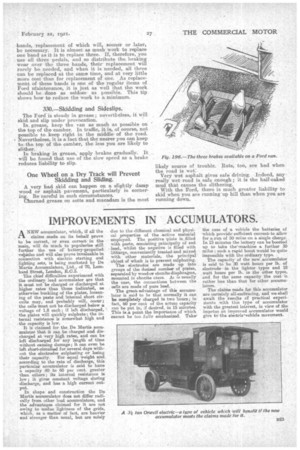IMPROVEMENTS IN ACCUMULATORS.
Page 27

If you've noticed an error in this article please click here to report it so we can fix it.
ANEW accumulator, which, if all the claims made on its behalf prove to be correct, or even correct in the main will do much to popularize still further the use of battery-propelled vehicles and will also prove invaluable in connection with electric starting and lighting sets, is being marketed by Be Martis Accumulators, Ltd., of 70, Lombard Street, London, E.C.3. The chief difficulties experienced with the ordinary lead accumulator are that it must not be charged or discharged at higher rates than those indicated, as otherwise buckling of the plates, loosening of the paste and internal short, circuits may, and probably will, °emir; the cells must not be discharged below a voltage of 1.8 oath; if left discharged, the plates will quickly sulphate; the internal resistance is somewhat high and the capacity is low. It is claimed for the De Martis accumulator that it. can be charged and discharged at very high rates, and can be left discharged for any length of time without causing damage; it can even be left short-circuited for several days without the electrodes sulphating or losing their capacity. For equal weight and according to the rate of discharge, this particular accumulator is said to have a capacity 40 to 60 per cent, greater than others; its internal resistance is low • it gives constant voltage during discharge, and has a high current output. In shape and construction the Be Martis accumulator does not differ radically from other lead accumulators, and the advantages claimed for it are not owing to undue lightness of the grids, which, as a matter of fact, are heavier and stronger than usual, but are solely due to the different chemical and physical properties of the active material employed, The positive .plate is.filled with paste, consisting principally of red lead, whilst the negative is filled with litharge, conveniently treated and mixed with other materials, the principal. object of which is to prevent sulphating. The electrodes are made up into groups of the deaised number of plates, separated by wood-or ebonite diaphragms, mounted in ebonite cases. Ai is usually the case, the connections between the cells are made of pure lead. The great. advantage of this accumulator is said to be that normally it can be completely charged in two hours; in fact, 60 per cent of the actual capacity \ can be put in; if desired, in 15 minntes. This is.a point the importance of which cannot be too. fully emphasized. Tako. the case of a vehicle the batteries of which provide sufficient current, to allow for a. run of 50 miles on a single charge. In 15 minutes the battery can be boosted up to take the'en.achine a further 30 miles ; such a rapid boost would be quite impossible with the ordinary type.
The capacity of the new,accumulator is said to be 30 watt hours per lb. of electrode'in the lighter types and 18 watt hours per lb. in the other types, and for the same capacity the cost, is rather less than that for other accumulators.
The claims made for this accumulator are certainly all-embracing, and we shall await the results of practical experiments with this type of acoumulator with the greatest interest, in view of the impetus an improved accumulator would give to the electrievehicle movement.






























